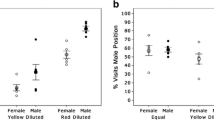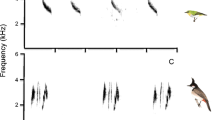Abstract
We examined the effects of nectar availability and competition on foraging preferences and revisit intervals of traplining female purple-throated caribs hummingbirds (Eulampis jugularis) to Heliconia patches shared by two individuals or visited solely by one individual. Birds at both shared and solitary patches preferred multiflowered to single-flowered inflorescences, but the magnitude of this preference depended on food availability and competition. During a year of low flower availability, females visited multiflowered inflorescences more frequently than single-flowered inflorescences only when nectar availability was experimentally enhanced; similarly, females at shared patches exhibited a significant preference for multiflowered inflorescences only after experimental increases in nectar availability. Experimental manipulations of nectar availability also had different effects on revisit intervals of birds at shared vs solitary patches. Birds at shared patches responded to patch-wide increases in nectar rewards by increasing the duration of their visit intervals, whereas birds at solitary patches did not. In contrast, birds at solitary patches responded to abrupt losses of nectar at flowers (simulating competition) by decreasing the duration of their visit intervals, whereas a bird at a shared patch did not alter its return interval. The contrasting results between shared vs solitary patches suggest that future studies of traplining behavior should incorporate levels of competition into their design.



Similar content being viewed by others
References
Cartar RV (2004) Resource-tracking by bumble bees: responses to plant-level differences in quality. Ecology 85:2764–2771
Charnov EL, Orians GH, Hyatt K (1976) Ecological implications of resource depression. Am Nat 110:247–259
Davies NB, Houston AI (1981) Owners and satellites: the economics of territory defense in the pied wagtail, Motacilla alba. J Anim Ecol 50:157–180
Feinsinger P (1976) Organization of a tropical guild of nectarivorous birds. Ecol Monogr 46:257–291
Garrison JSE, Gass CL (1999) Response of a traplining hummingbird to changes in nectar availability. Behav Ecol 10:714–725
Gill FB (1988) Trapline foraging by hermit hummingbirds: competition for an undefended, renewable resource. Ecology 69:1933–1942
Gill FB, Wolf LL (1977) Nonrandom foraging by sunbirds in a patchy environment. Ecology 58:1284–1296
Hudson PJ, Sugden AM (1984) Inflorescence production by Brownea rosa-de-monte (Leguminosae) and feeding behavior of the long-tailed hermit Phaethornis superciliosus. Ibis 126:416–420
Janzen DH (1971) Euglossine bees as long-distance pollinators of tropical plants. Science 171:203–205
Krebs JR, Erichsen JT, Webber MT, Charnov EL (1977) Optimal prey selection in the great tit (Parus major). Anim Behav 25:30–38
Lemke TO (1984) Foraging ecology of the long-nosed bat, Glossaphaga soricina, with respect to resource availability. Ecology 65:538–548
MacArthur RH, Pianka EL (1966) On optimal use of a patchy environment. Am Nat 100:603–609
Makino TT, Sakai S (2005) Does interaction between bumblebees (Bombus ignitus) reduce their foraging area?: bee removal experiments in a net cage. Behav Ecol Sociobiol 57:617–622
Minitab Inc. (1997) Minitab user’s guide release 12 for Windows. State College, Pennsylvania
O’Brien RG, Kaiser MK (1985) MANOVA method for analyzing repeated measures designs: an extensive primer. Psychol Bull 97:316–333
Ohashi K, Yahara T (1998) Effects of variation in flower number on pollinator visits in Cirsium purpuratum (Asteraceae). Am J Bot 85:219–224
Paton DC, Carpenter FL (1984) Peripheral foraging by territorial rufous hummingbirds: defense by exploitation. Ecology 65:1808–1819
Rice WR (1989) Analyzing tables of statistical tests. Evolution 43:223–225
SAS Institute (1999) SAS/STAT user’s guide, version 8. SAS Institute Inc., Cary NC
Sazima I, Buzato S, Sazima M (1995) The saw-billed hermit Ramphodon naevuis and its flowers in southeastern Brazil. J Ornithol 136:195–206
Schoener TW (1974) The compression hypothesis and temporal resource partitioning. Proc Natl Acad Sci USA 71:4169–4172
Stiles FG, Wolf LL (1979) Ecology and evolution of lek mating behavior in the long-tailed hermit hummingbird. Ornithol Monogr 27:78
Temeles EJ, Kress WJ (2003) Adaptation in a plant-hummingbird association. Science 300:630–633
Temeles EJ, Pan IL, Brennan JL, Horwitt JN (2000) Evidence for ecological causation of sexual dimorphism in a hummingbird. Science 289:441–443
Temeles EJ, Muir AB, Slutsky EB, Vitousek MN (2004) Effect of food reductions on territorial behavior of purple-throated caribs. Condor 106:691–695
Temeles EJ, Goldman RS, Kudla AU (2005) Foraging and territory economics of sexually dimorphic purple-throated caribs (Eulampis jugularis) on three Heliconia morphs. Auk 122:187–204
Thomson JD (1981) Spatial and temporal components of resource assessment by flower-feeding insects. J Anim Ecol 50:49–59
Thomson JD (1988) Effects of variation in inflorescence size and floral rewards on the visitation rates of traplining pollinators of Aralia hispida. Evol Ecol 2:65–76
Thomson JD, Plowright RC (1980) Pollen carryover, nectar rewards, and pollinator behavior with special reference to Diervilla lonicera. Oecologia 46:68–74
Thomson JD, Peterson SC, Harder LD (1987) Response of traplining bumblebees to competition experiments: shifts in feeding location and efficiency. Oecologia 71:295–300
Tiebout HM III (1992) Comparative energetics of divergent foraging modes: a doubly labeled water experiment on hummingbird competition. Anim Behav 44:895–906
Tiebout HM III (1993) Mechanisms of competition in tropical hummingbirds: metabolic costs for losers and winners. Ecology 74:405–418
Werner EE, Hall DJ (1974) Optimal foraging and the size selection of prey by the bluegill sunfish (Lepomis macrochirus). Ecology 55:1216–1232
Wolf LL (1975) Female territoriality in the purple-throated carib. Auk 92:511–522
Wolf LL, Hainsworth FR (1971) Time and energy budgets of territorial hummingbirds. Ecology 52:980–988
Wolf LL, Hainsworth FR (1986) Information and hummingbird foraging at individual inflorescences of Ipomopsis aggregata. Oikos 46:15–22
Wolf LL, Hainsworth FR (1991) Hummingbird foraging patterns: visits to clumps of Ipomopsis aggregata inflorescences. Anim Behav 41:803–812
Wolf LL, Wolf JS (1971) Nesting of the purple-throated carib hummingbird. Ibis 113:306–315
Acknowledgements
We thank Jazmine Arroyo, Vinita Gowda, and Silvana Marten-Rodriguez for help with data collection, Donald Anthony and Alwin Dornelly of the St. Lucia Forestry Department for advice and cooperation, and M. Elgar and two anonymous reviewers for comments on the manuscript. Esther and Franz Louis-Fernand generously provided accommodations and hospitality. This research was supported by Amherst College Faculty Research Awards and NSF grant IBN-0078483 to EJT. Our research complies with the laws and regulations of the Government of St. Lucia.
Author information
Authors and Affiliations
Corresponding author
Additional information
Communicated by M. Elgar
Rights and permissions
About this article
Cite this article
Temeles, E.J., Shaw, K.C., Kudla, A.U. et al. Traplining by purple-throated carib hummingbirds: behavioral responses to competition and nectar availability. Behav Ecol Sociobiol 61, 163–172 (2006). https://doi.org/10.1007/s00265-006-0247-4
Received:
Revised:
Accepted:
Published:
Issue Date:
DOI: https://doi.org/10.1007/s00265-006-0247-4




